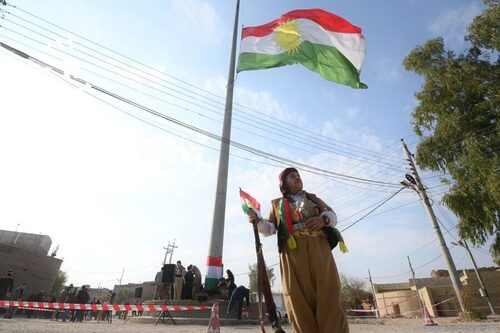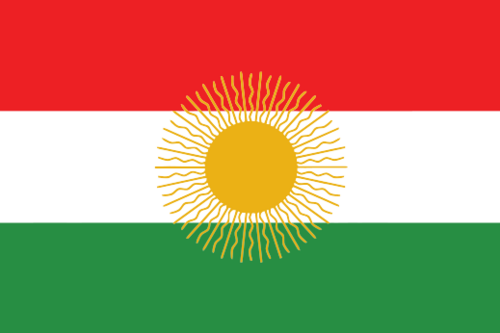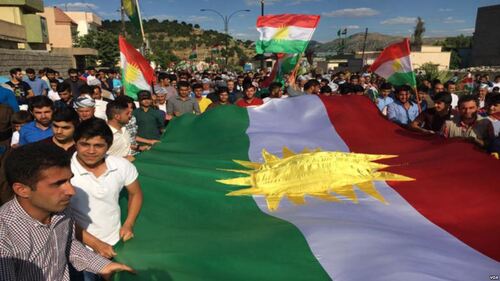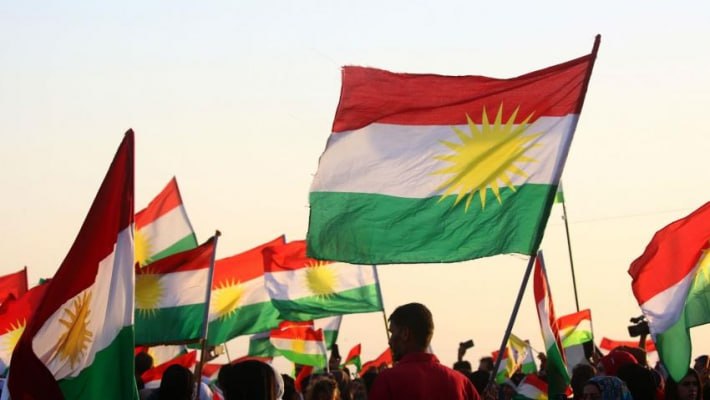Regarding the former Kurdistan flag, the writer Luqman Polat wrote: "As is known, the Medes are the ancestors of the Kurds." The Medes established a great empire in history. The Median flag was as follows:
The top is a red color, with a yellow crown within the red color. In the middle, there is a white color with a picture of a lion and behind the lion, sunlight comes out, the sun is yellow and the lion is a jewel, at the bottom there is a green color with no picture.
We can say that the flag of the Median Empire is red at the top, white in the middle, and green at the bottom, only the images inside are not the same.
Of course, after the Median period, Kurdistan's rulers and emirates had their logos and flags, but no confirmed information is available.

In modern times
In 1919, Mamduh Salim Bag of Wan designed the first Kurdistan flag and the Social Organization Association approved it in Istanbul.
Red on top, white in the middle, green on the bottom. The image of the sun was also in the middle of the flag.
Znar Slopi (Qadri Jamil Pasha) confirmed this information in his book Doza Kurdistane.
However, despite this information, some sources say that this flag was first designed and approved by the Kurdistan Supreme Association. The association was founded in 1918 in Istanbul to establish an independent Kurdish state.
In his research on the identity card of the Kurdistan Supreme Association, author Mahmoud Lawandi wrote: “The identity card of Supreme Association, made by author Zainal-Abedin, was green and had a sun in the middle”.
The writer and researcher Kone Rash wrote about the creation and approval of the Kurdistan flag: “In early 1919, at a meeting of the Kurdistan Supreme Association in Istanbul, led by the second president of the Kurdistan Supreme Association, Mir Amin Ali Badrkhan (Sheikh Abdul Qadir Nahri was the president of the association at that time), it was decided to cleanse Kurdistan from Turkish and foreign forces and declare Kurdistan's independence. A free and independent Kurdistan needed a flag, so Amin Ali Badrkhan suggested the colors of the Kurdistan flag that he had chosen for his friends in a meeting. They unanimously accepted the proposal, which looked exactly like the current Kurdistan flag.

Whether it is the flag of the Social Organization Association or the Kurdistan Supreme Association, according to information, it was placed in March 1921 by the hero Alisher and Dr. Nuri Dersimi on Mount Kochgri in Dersim, North part of Kurdistan.
In 1921, Mustafa Pasha Yamulki, one of the founders of the Social Organization Association, who was originally from Sulaimani, moved to Sulaimani from Turkey and attended the proclamation of the government of Sheikh Mahmud Barzanji (10.10.1922). He was later appointed Minister of Education. He was also responsible for the semi-official newspaper Bangi Kurdistan.
Although Yamulki had previously played a role in the confirmation of the Kurdistan flag as a member of the Social Organization Association, there is no document that Sheikh Mahmud Barzanji (1956-1878) asked Yamulki about the design of the flag. According to some sources, Sheikh Mahmud's government's flag was green with the moon's image in white inside a red circle.
The same flag approved by the Social Organization Association was officially recognized in 1927 by the Khoybun Organization and sent to Ihsan Nuri Pasha, who placed it on Mount Agri. Ihsan Nuri Pasha (1893-1976), the hero of the Agri Revolution, writes about the Kurdistan flag in his memoirs:
“I prepared a military group of brave Kurdish youths and placed the Kurdistan flag on top of Mount Agri. The Rumi (Turkish) forces were around Bayezid City. The hero guardians of Agri clapped far away. At that time there was a Kurdish military organization and administration in Agri.

The same flag is printed in color on the cover of Suraya Badrkhan's book, she is also one of the founders of Khuybun. Below the flag is written "Flag of Kurdistan" in English.
The writer Kone Rash says: The flag that Khuybun adopted was the same as that of Rawshan Badrkhan, the wife of Jaladat Badrkhan. Rawshan gave me the flag and when Rawshan's daughter, Sinam Badrkhan, came to my house in Qamishlo, I gave her the flag she still keeps in Erbil.
The Turkish newspaper Vakt published a report on August 17, 1930, about the joint Turkish-Iranian operation against the Agri revolutionaries. They have put up a flag with the words "Flag of Khuybun Association" below it.
In its 11th issue, which was reprinted on 10-11-1932, Hawar magazine published the three-color Kurdistan flag on its cover.
William L. Eagleton, author of the Kurdistan Republic 1946, writes about the Kurdistan flag:
“In May 1942, members of the Revival of Kurdistan with members of the Hiwa Party created a flag that had the opposite colors of the Iranian flag: red at the top, white in the middle, and green at the bottom. In the middle, there was an image of the sun, two wheat branches on the edge of the sun, and there was a picture of a pencil and a mountain.”
The Kurdistan flag was hoisted for the first time in the East part of Kurdistan on December 17, 1945, on the roof of the Mahabad municipal building. On January 22, 1946, the Kurdistan Republic was proclaimed by Commander Qazi Mohammad, and the Kurdistan flag was hoisted again.

That flag was the same as the green, red, and yellow flag adopted by Khuybun, but the only difference was that there were two symbols of wheat at the edge of the sun and a pencil on the upper side of the sun where the sun had not fully risen.
In his memoirs, Musa Antar describes an organization he founded in 1948 with Yusuf Azizoglu and several other Kurds. He describes the Kurdistan flag: “I was responsible for preparing the Kurdistan flag. I bought four colors of fabric. Red, white, green, and yellow. The symbols of the colors and sun are as follows: White is peace, red is blood and revolution, and green is the blessing of Kurdistan and Mesopotamia. The sun is the symbol of the Kurdish religion, Zoroastrianism."
In 1999, the Kurdistan Regional Government (South part of Kurdistan) parliament officially adopted the Kurdistan flag, which was the same as that adopted by Khuybun. The only difference was that instead of 18 beams, it had 21 beams.
In 2009, the Kurdistan Regional Government (KRG) Parliament decided to declare December 17 as Kurdistan Flag Day. On December 17, 1945, the Kurdistan flag was hoisted in Mahabad.

The Kurdistan flag that became the official flag of the southern part of Kurdistan is as follows:
The top is red, the middle is white, and the bottom is green.
The sun is decorated with 21 equal rays, marking March 21 and the beginning of spring (Newroz).
The sun symbolizes freedom and light.
Red symbolizes the blood of Kurdistan's martyrs.
Green represents the nature of Kurdistan.
White is a symbol of the peacefulness of the Kurdish people.
Many poems have been written about the colorful Kurdistan flag, the most famous of which are written by the following poets and writers:
Mullah Jaziri, Ahmad Khani, Osman Sabri, Jgarkhwen, Taha Mayi, Ahmad Nami, Mir Jaladat Badrkhan, Harakol Azizan, Mir Dr. Kamiran Badrkhan, Hazhar Mukriani, etc.
Resources:
1- History of the Kurdistan Flag, the colorful flag by Qado Shirin
2- History of the Kurdistan Flag – Tishk Magazine (govartishk.com)
3- The current Kurdistan flag is the flag of all Kurdistan by Dr. Zryan Haji
4- Vakit 17 Ağustos 1930 Sayfa 1 | Gaste Arşivi (gastearsivi.com)
5- Dîroka Ala ya Kurdistanê (kurdistan24.net)
6- Kurdistan Flag - Wikipedia, the free encyclopedia (wikipedia.org)
7- The history of the Kurdistan flag goes back to before the Kurdistan Republic | Rojpress (wordpress.com)
8- Kurdistan Regional Flag Law No. 14 of 1999
Happy Kurdistan Flag Day 17/12/2021 #Law | By Lawyer Diyar Dilshad | Facebook








